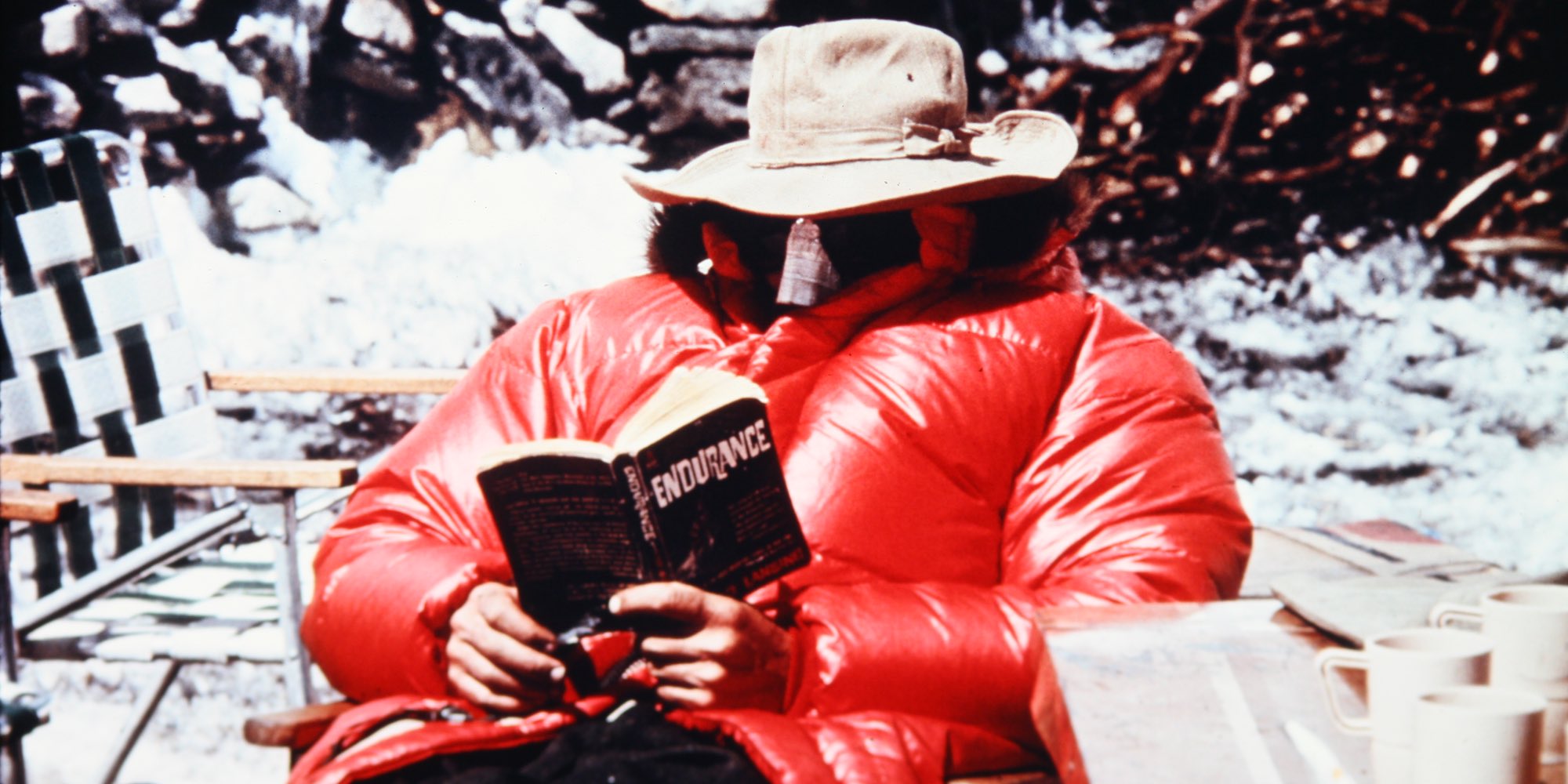“So … what is this place?” That’s probably the most common question I hear, as a librarian, when people walk into the American Alpine Club Library (AAC) in Golden, Colorado, for the first time.
It could be mistaken for any other library—except for the display cases showing off mountaineering artifacts and the paintings and photographs of mountains. The AAC Library focuses on mountain-centered publications—but on a deeper level, the librarians seek to both preserve climbing history and provide resources to today’s climbing community.
The library started with a single person: Henry Montagnier, a mountaineer and alpine historian who collected books focused mainly on the Alps, originally keeping his collection in Italy. But as the political climate destabilized leading up to World War I, Montagnier first relocated his collection to Switzerland, and then eventually offered it to the American Alpine Club for safekeeping. AAC members began to add their own mountaineering books and expedition materials, growing the collection’s size and scope.

Photo Courtesy: AAC Library
Today the collection is housed in the American Mountaineering Center in Golden, Colo., and has expanded to more than 50,000 items—not including archives and artifacts—ranging from the newest edition of the guidebook to your local crag to the 450-year-old On the Admiration of Mountains by Conrad Gesner. More than 20,000 maps, books and videos are available for circulation to American Alpine Club members.
Surrounded by such a voluminous collection, the library staff gets to read and discuss a lot of interesting books. As the library manager, I get the most joy from being able to assist patrons discussing climbing and planning their next adventure. Library Director Katie Sauter says one of the most exciting parts of her job is reading mountaineering accounts, and then being able to dive into the backstory in the AAC Library’s archives. From expedition letters and photographs to historic gear and summit registers, these stories come to life at the library. Katie and I teamed up to bring you our favorite picks from the library.

Photo Courtesy: AAC Library
Katie Shares Her Favorite Picks:
Lost Horizon by James Hilton (1933)
This is a classic adventure story and the only novel on this list. British diplomat Hugh Conway flees civil unrest in Afghanistan only to crash in the Himalayas. He and the other survivors are found and led to the mythical Shangri-La, where they discover a hidden utopia. Equally enjoyable is the film of the same name by Frank Capra.
Everest: The West Ridge by Tom Hornbein (1965)
This is the story of one of the greatest achievements in American mountaineering history: Willi Unsoeld and Tom Hornbein climbing to the top of the world from Everest’s West Ridge, descending from the South Col and bivouacking at 28,000-feet. It is a great story of determination, passion and friendship. I love to read about the long treks in earlier expeditions to the Himalayan or Karakoram peaks, before the airport at Lukla was built in the ’60s. Prior to that time, mountaineers had to walk 200 miles just to get to the base of Everest. One of my favorite things about this book is the many outstanding photographs paired with quotes about mountains.
Starlight and Storm by Gaston Rébuffat (1968)
Although this was written 50 years ago, the writing is timeless, even in translation. Rébuffat was the first person to climb the six great north faces of the Alps: the Grandes Jorasses, the Piz Badile, the Dru, the Matterhorn, the Cima Grande di Lavaredo, and the Eiger. With such an impressive climbing resume, you might expect an ego to get in the way, but this is not the case with Rébuffat. His joy from being in the mountains shines through at every corner. This book left me feeling refreshed and cheerful.
Glorious Failures compiled by the editors at Mountaineers Books (2001)
This is the first volume in the Mountaineers Anthology Series. It is a collection of near-success stories from well-known climbers like Terris Moore, Herman Buhl, H.W. Tilman, Eric Shipton, Fritz Wiessner and Joe Simpson. These are not so much tales of death and disaster, but of having to turn back. It’s nice to know that even the most experienced climbers don’t always find success. This book was really a sampling, since each of these stories came out of other larger books, so I found at least eight more books to add to my reading list.
Colorado 14er Disasters: Victims of the Game by Mark Scott-Nash (2009)
Disasters and accidents in the mountains are always a draw. We have a few shelves in the AAC Library completely dedicated to search and rescue tales. Mark Scott-Nash was a longtime member of Rocky Mountain Rescue group based in Boulder. This is his second book, and it’s full of lessons learned from poor decision-making or plain bad luck. The first time I read it, I thought, “all these people are so stupid.” The second time, I realized that many of these accidents could easily happen to any of us. From beginners to experts, anyone can make a mistake or be in the wrong place when rocks fall.

Photo Courtesy: AAC Library
My Picks:
Endurance by Frank Arthur Worsley (1931)
This book recounts Ernest Shackleton’s 1914–1916 attempted Antarctic crossing. Endurance is quite simply exciting to read from cover to cover. Instead of a story of the perils Shackleton encountered while traversing a frozen continent, we get a lost-at-sea, deserted-island tale of survival and mountaineering. The book is a must-read for anyone with any interest in survival stories.
Men Against the Clouds: The Conquest of Minya Konka by Richard Burdsall and Arthur Emmons (1935)
If you wanted to make a 1990s-style action-adventure film, all you’d have to do is take this book, add an ancient treasure on the summit, and cast a good-looking hero as your lead. Men Against the Clouds tells the story of the 1932 Sikong expedition and the first ascent of Gongga Shan by four American men. In contrast to most mountaineering books, the mountain seemed like the least dangerous part of their journey. On the approach and return trip from the peak, the men had to be wary of bandits and warlords on the 2,000-mile long journey up the Yellow River, in river boats of varying condition, through a growing military conflict with the Japanese.
Into Thin Air by Jon Krakauer (1997) and The Climb by Anatoli Boukreev (1997)
Reading these two books together paints a fuller picture than either one alone. Into Thin Air was published roughly a year after the 1996 Everest disaster, and The Climb quickly followed as a rebuttal to Krakauer’s portrayal of decisions made by Boukreev while on the mountain. Because of these quick turnarounds, both books are raw with emotion. Reading one without the other is easier because you’ll be able to walk away “knowing” where the fault lies for the disaster. Reading both makes you realize every story is more complicated than it first appears.
Freedom Climbers by Bernadette McDonald (2011)
I picked up Freedom Climbers thinking it would be interesting to read about a lesser-known part of climbing history, only to learn that I was simply naïve and oblivious to one of the most extraordinary generations of climbing. The book is sometimes difficult to follow—there are a lot of mountaineers, climbs and expeditions coming at you quickly—but McDonald paints a colorful narrative that creates a complete picture of the climbers and the circumstances that created the golden age of Polish mountaineering. The biggest takeaway from this book is that, in order to be on the cutting edge of mountaineering, you have to enjoy suffering.
